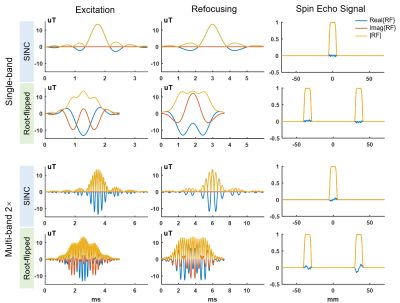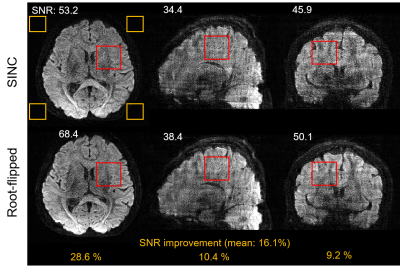0968
SNR-Enhanced High-Resolution Diffusion Imaging Using 3D Simultaneous Multi-Slab (SMSlab) with Root-flipped RF Pulse Design1Center for Biomedical Imaging Research, Department of Biomedical Engineering, School of Medicine, Tsinghua University, Beijing, China, 2Department of Radiology, Stanford University, Stanford, CA, United States
Synopsis
3D simultaneous multi-slab (SMSlab) is a technique to increase SNR efficiency in high-resolution diffusion imaging. However, it still suffers from the intrinsic low SNR of diffusion MRI, especially when using multi-band RF pulses, which increases the pulse duration and thus lengthens the echo time. In this study, root-flipped RF pulses were used in SMSlab to acquired 1 mm isotropic 3D diffusion images. With a multi-band factor of 2, the root-flipped pulses brought about 12 ms reduction of TE (from 91 to 79 ms), and 16% SNR gain, compared to traditional SINC pulses.
Introduction
The 3D simultaneous multi-slab (SMSlab) technique has been proposed for isotropic high-resolution diffusion imaging 1-4. It is more SNR efficient than 2D techniques, but still suffers the intrinsic low SNR of diffusion MRI, especially for high resolution imaging. SMSlab is more acquisition efficient than 3D multi-slab techniques. However, as its RF pulses are multi-banded, SMSlab has longer RF pulse duration than multi-slab, which results in longer echo time (TE) and further degrades the image SNR. The root-flipped RF pulses have been demonstrated to achieve shorter pulse durations for a given RF peak amplitude 5,6. It is played with constant trapezoid gradient waveforms, thus is not dictated by the slew rate of gradient systems 5, and less sensitive to off-resonance distortion and gradient errors, compared to other methods such as VERSE 7. In this study, the RF pulses in SMSlab were root-flipped to reduce pulse duration and thus TE. The improvement of SNR using root-flipped pulses compared to the original SINC pulses was investigated.Methods
This study was approved by the local Institutional Review Board and written informed consent was obtained from the healthy volunteer. Whole-brain diffusion data were acquired using the SMSlab technique, in-plane 4-shot interleaved EPI and a 32-channel head coil on a Philips 3.0T Achieva TX MR scanner (Philips Healthcare, Best, The Netherlands). The maximum gradient strength and slew rate are 100 mT/m and 80 T/m/s, respectively.To formulate a 3D k-space in SMSlab, the inter-slab gap induced phase interference, which is caused by the gap between the simultaneously excited slabs in the presence of kz encoding gradient, can be removed by phase-modulating the RF pulses 3,4. This requires different phase modulation of single-band RF pulses in different kz encodings, namely different multi-band pulses for different kz encodings. For convenience, only the single-band excitation and refocusing pulses are optimized with root-flipping. They are stored in the scanner’s RF library, and modulated to generate multi-band pulses online during the scan. The root-flipped pulses are designed using the toolbox (https://github.com/wgrissom/gSliderRF). SINC pulses were conducted for comparison. Parameters of both pulses are listed in Table 1.
The 1 mm isotropic DWI images were acquired by SMSlab, with multi-band factor = 2. There are 14 slabs in total, each slab contains 12 slices, with 20% kz oversampling. Adjacent slabs were overlapped by 2 slices. Other parameters were: FOV = 220×220×140 mm3, flip angle = 90 degree, 1 b0 and 1 diffusion with b = 1000 s/mm2, partial Fourier = 0.7, TE1/TE2 = 91/187 ms for the SINC pulse and 79/180 ms for the root-flipped pulse, TR = 1800 ms, acquisition time = 2 min 53 s.
The SMSlab data were reconstructed in a 3D-kspace framework 3.
The SNR was calculated using $$$SNR=\overline{\mu}/\sigma$$$, where $$$\overline{\mu}$$$ was the mean signal in each red rectangle in Figure 3, and $$$\sigma$$$ was the standard deviation of the signals in the four corners of each image (yellow rectangles in Figure 3), respectively.
Results and Discussion
Figure 1 shows the single-band and multi-band (2×) RF waveforms of both the SINC and root-flipped pulses, and the corresponding spin echo signal profiles, when kz encoding gradient strength equals zero. Setting the RF peak amplitude to the scanner’s maximum RF amplitude of 13.5 uT, the root-flipped pulses have shorter duration than the SINC pulses (Table 1).Figure 2 shows the sequence diagram of SMSlab. When multi-band was applied, there came a non-zero period GAPMB by default, between the second diffusion gradient and the kz encoding gradient. While for single-band, GAPMB = 0. This period is possibly set by the scanner software because of the duty cycle limit considering system heating 8. The root-flipped pulses resulted in shorter GAPMB compared to the SINC pulses (Table 1). The 5.12 ms reduction of the refocusing pulse and 4.53 ms reduction of GAPMB result in approximate 12 ms reduction of TE1 (Table 1).
Figure 3 shows the SNR comparison between the root-flipped and SINC pulses. Diffusion images are shown from three different views. The SNR improvement using the root-flipped pulses are visually observable. Quantitatively, with shorter TE, the root-flipped pulses provide about 16% average SNR gain compared to the SINC pulses. This is close to the theoretical value (18%) calculated from Bloch simulation 9, with T1/T2 = 840/70 ms 4.
Conclusion
This study demonstrates the ability of root-flipped RF pulses to reduce TE and thus increase image SNR. For 1 mm isotropic diffusion images acquired by simultaneous multi-slab with a multi-band factor of 2, root-flipped RF pulses can reduce TE from 91 ms to 79 ms, which improves the image SNR by 16%.Acknowledgements
The authors would like to thank Jun Ma in Vanderbilt University for helpful discussions about root-flipped RF pulses.References
1. Frost R, Jezzard P, Porter DA, Tijssen R, Miller K. Simultaneous multi-slab acquisition in 3D multi-slab diffusion-weighted readout-segmented echo-planar imaging. In Proceedings of the 21st Annual Meeting of ISMRM. Salt Lake City, Utah, USA, 2013. p 3176.
2. Bruce IP, Chang H-C, Petty C, Chen N-K, Song AW. 3D-MB-MUSE: A robust 3D multi-slab, multi-band and multi-shot reconstruction approach for ultrahigh resolution diffusion MRI. NeuroImage 2017;159:46-56.
3. Dai E, Wu Y, Guo H. High-Resolution Isotropic Diffusion MRI Using Simultaneous Multi-slab (SMSlab) Acquisition. In Proceedings of the 27th Annual Meeting of ISMRM. Montreal, Canada, 2019. p. 0774.
4. Dai E, Wu Y, Wu W, et al. A 3D k-space Fourier encoding and reconstruction framework for simultaneous multi-slab acquisition. Magn Reson Med 2019;82(3):1012-1024.
5. Sharma A, Lustig M, Grissom WA. Root-flipped multiband refocusing pulses. Magn Reson Med 2016;75(1):227-237.
6. Ma J, Witzel T, Grissom WA, Setsompop K. Minimum peak power root-flipped gSlider-SMS RF pulses for high-resolution in vivo diffusion imaging. In Proceedings of the 25th Annual Meeting of ISMRM. Honolulu, USA, 2017. p. 0523.
7. Conolly S, Nishimura D, Macovski A, Glover G. Variable-Rate Selective Excitation. J Magn Reson 1988;78(3):440-458.
8. Bernstein MA, King KF, XJ Z. Handbook of MRI pulse sequences. New York: Elsevier Academic Press; 2004.
9. Mills TC, Ortendahl DA, Hylton NM, Carlson JW, Crooks LE, Kaufman L. Variable Flip Angle Excitation for Reduced Acquisition Time Magnetic-Resonance-Imaging. Ieee T Nucl Sci 1987;34(1):304-308.
Figures



